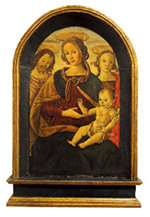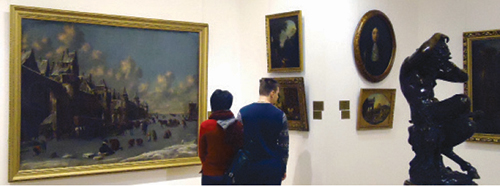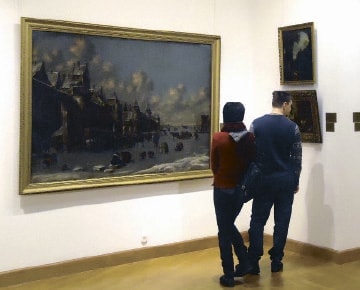 The Mater Dei. Iconografia di un Amore exhibition, at the National Art Museum of Belarus, is showcasing artworks from state and private collections, from the Italian city of Perugia. The Italian Ambassador to Belarus, Stefano Bianchi, noted at the opening, “This exhibition is unprecedented. Such a project has never been conducted in Belarus, and our neighbours can’t boast of having organised something similar.”
The Mater Dei. Iconografia di un Amore exhibition, at the National Art Museum of Belarus, is showcasing artworks from state and private collections, from the Italian city of Perugia. The Italian Ambassador to Belarus, Stefano Bianchi, noted at the opening, “This exhibition is unprecedented. Such a project has never been conducted in Belarus, and our neighbours can’t boast of having organised something similar.”
The diplomat explained that Perugia is his native city, saying, “I’ve grown up among the arts.” According to the Ambassador, Perugia has played a significant role in Italian culture. Some of the pictures being exhibited in Minsk have never yet been on public display, even in Italy, whose cultural heritage is so great that it is yet to be fully studied.
The current exhibition’s works are united by the common theme of Madonna and Child: the iconographic images by Italian masters of drawing and engraving date from the 15th century through to the 19th. The cult of the Virgin Mary occupies an important place in Christianity, with the depiction of Madonna and Child being the most popular theme in Christian art for many centuries. Inspired originally by the Gospels, additional influences were gathered as time passed.
Magnificent images of Madonna and Child enthroned, based on Byzantine traditions, began to spread to the West in the 7th century and, during the Crusades, the image acquired special veneration, becoming the centre of a cult. The Renaissance brought the development of realism and creative individuality, stimulating a breaking away from old iconographic canons, allowing the appearance of a freer style. The sacral Virgin and Child was replaced by less formalised images, such as Madonna Humility (depicted sitting on the ground) and Mother of Tenderness (Mater Amabilis). The Renaissance emphasised the maternal aspect of the relationship between Mary and Jesus. The Virgin Mary of Mercy holds her cloak open over those seeking her protection, or kneels to Christ on Judgment Day: a new theme in Christian art. From the late 16th century and throughout the 17th century, depictions of the Virgin Mary’s apparitions to the saints enjoyed great popularity.
Among the Madonna and Child images on display at the exhibition are the following:
Madonna Lactans (Virgo Lactans or Maria Lactans) is the most ancient of the Mary and Child themes, dating from pre-Christian art. The Renaissance painting appears in several versions, depiction Mary sitting on a throne or directly on the ground (Madonna of Humility) or standing. One such is Madonna and Child with Saint John the Baptist, from Perugia’s Academy of Fine Arts (named after Pietro Vannucci).
Madonna and Child Enthroned presents the Virgin Mary in her role as a symbol of the Church itself. Engravings by Carlo Lasinio and Matteo Carboni reproduce originals by Guido da Siena and Duccio di Buonunsegna.
The Virgin Mary With Hands Clasped in Prayer — in the Posture of Adoration, by Bernardino Fungai, held by the National Gallery of Umbria, shows the child on his mother’s knee. Similar works, such as that by an unknown early 19th century artist, from Perugia’s Academy of Fine Arts (named after Pietro Vannucci), shows the baby on the ground. Both are typical examples of iconography.
The Virgin Mary Mother is a simple image of the Madonna holding a child. During the Renaissance, increasingly levels of emotion were portrayed, with less pure religious significance. Meanwhile, various symbolic objects were shown nearby: fruit, birds and vessels. An apple, representing the tree of knowledge, was commonly painted, such as in the 15th century canvas by an unknown artist, on loan from the Academy of Fine Arts of Perugia (named after Pietro Vannucci), and that by an unknown 16th century artist, on loan from the National Art Gallery of Umbria.
The Image of the Virgin Mary with Figures of Saints, designed to sit above the church altar, with symmetrical panels, was a typical form of art in the late Middle Ages and early Renaissance. Each section would hold a separate figure. By the 14th-15th century, single images were more common, grouping saints in a ‘Sacra Conversazione’, either standing or kneeling in the presence of the Virgin Mary. The latter usually sits on a throne or stands in eminence. Saints from various times would be depicted together, with each chosen in particular: such as for being the patron of the church for which the work was ordered. Those created for monastic orders would often include images of the founder of the order and of other saints.
Images of holy men can personalise moral and intellectual qualities, often shown in paired combinations. The exhibition features Madonna with Child, with Saint John the Baptist and Mary Magdalene, by a Tuscan follower of Perugino, from the collection of the Savings Bank of Perugia. On show also is Madonna with Child and Saint James the Apostle and Saint Francis of Assisi, as well as Madonna with Child and Nun Giacoma — by an unknown artist of the 15th century, on loan from the National Gallery of Umbria. Works by Giacomo and Giulio Raibolini (named the Francia) as well as engravings executed by Giovanni Antonio Lorenzini, from Perugia’s Academy of Fine Arts, are sure to delight visitors.

The Holy Family was a common theme by the 15th century, showing Saint Joseph the Betrothed with Mary, depicted in their earthly home, with Jesus. Such icons are on loan from Perugia’s Academy of Fine Arts.
The Adoration of the Shepherds emphasises the open nature of the Christian faith, in which simple shepherds arrived before the regal Magi in visiting the baby Jesus. The genuine joy of the situation is presented in a work by an unknown artist of the 17th century, copied from an engraving by Pietro Santi Bartoli (after an original by Annibale Carracci) and engravings by Gaetano Vascellini and Matteo Carboni, on loan from the National Art Museum of the Republic of Belarus.
The Flight of the Holy Family into Egypt and Resting on the Path to Egypt are among the last (chronological) scenes associated with the infancy of Jesus. On show is a print by an unknown 17th century engraver, from the National Art Museum of Belarus.
Despite their common theme, the icons are diverse in technique and composition, reflecting changing stylistic trends through the centuries. Besides all belonging to the Italian art school, they form a general statement of faith, love and tenderness, via Adoration and Madonna and Child images. They are both religious and artistic, ranging from the 15th-19th century. Most were painted during the greatest period of European culture, the Renaissance, and are characterised by secular elements and anthropocentrism (interest in individuals). The fine arts of the Renaissance was marked by growing Realism, which influenced the spread of secular motives, the portrait genre, interest in landscapes, new interpretations of religious plots, and a radical new art system.
17th-19th century works continue Renaissance traditions while showing new stylistic trends of the Baroque Age and Classicism. Those from the 19th century, by unknown artists, are mainly from the Didactic Fund of the School of Drawing of the Academy of Fine Arts of Perugia. 17th-early 19th century engravings served to guide painters of forthcoming generations.
The Mater Dei. Iconografia di un Amore exhibition has artistic, aesthetic and educational relevance.
By Victor Mikhailov











